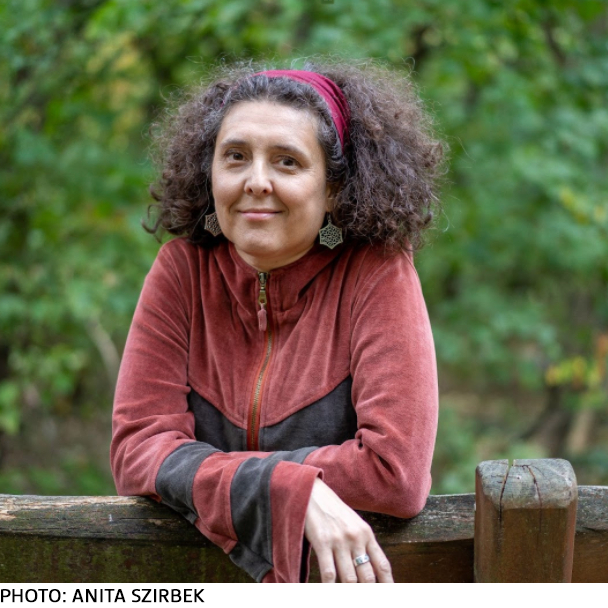How did you initially become involved in activism?
In 2004 I began to make connections to the Labrisz Lesbian Association. It was an intensive year when I came out to myself and others. Activism has always interested me, and through my volunteer work with the Labrisz Lesbian Association, I realized this is something I want to do. This work excites me.
Tell me more about your work with the Labrisz Lesbian Association.
This excitement led me to take on more tasks, and I have served as a rotating board member during my time with the organization. Before Labrisz Lesbian Association published our well-known bestseller, A Fairytale for Everyone, we also published six other books, including an LGBTQI handbook for teachers, lesbian biographies and literary works, and Secret Years. Secret Years was a documentary directed by Labrisz member Mária Takács, based on interviews with lesbians who were young during state-socialist times. We then published the interviews in a book. In addition to publishing, our organization hosts regular community events and discussions, which create space for the LGBTQI community to celebrate, connect, and heal.
Labrisz Lesbian Association runs a program within Hungarian schools for adolescents that discusses sexual orientation and gender identity (SOGI). But unfortunately, the Hungarian government has made it difficult for us to continue this work due to new restrictions regarding NGOs’ involvement in schools. Even though our community is under attack, Labrisz Lesbian Association is currently working with an archivist to preserve the stories and experiences of LBT women in Hungary.
How did you curate and choose authors when creating A Fairytale for Everyone?
Through our work with adolescents in schools, we saw the need to engage a younger audience in messages of acceptance and diversity, not only limited to LGBTQI representation. This idea took shape over several years. Labrisz Lesbian Association posted a call for writers and poets to submit their drafts and received over 100 stories. Besides featuring the work of well-known, popular writers, it was important that we amplify emerging and amateur authors and address a mix of social issues. This led to curating an anthology crafted by different authors from different backgrounds and experience levels. Some stories in A Fairytale for Everyone reflect LGBTQI representation, but we also included stories with Roma heroes, stories about non-conforming gender norms, disabilities, divorce, child adoption, and relationship violence. All 17 stories are equally loved and special.
What are the current political and social realities for LGBTQI communities in Hungary?
Hungary has joined the transnational anti-gender movement. The presiding Hungarian government has been leading an autocratic attack on human rights and sexuality/gender since 2010, but in 2019, this siege against the Hungarian LGBTQI community intensified.
The first step was the revocation of the right of legal gender change for trans people in 2020, then a constitutional amendment that redefined marriage as “a union between a man and woman,” but this was just the beginning. Since then, the Hungarian government has restricted adoption to solely married couples, prohibited depictions of homosexuality and gender transition in schools and the media, and mandated that children’s books depicting homosexuality or gender transition be sold in closed packaging. Some of the most recent changes take a direct aim at A Fairytale for Everyone and Labrisz Lesbian Association’s SOGI education program.
What is next for A Fairytale for Everyone?
When I initially managed A Fairytale for Everyone, it was still a small project. We had no idea of the impact it would make within Hungary and internationally. When it was published, Hungarians bought copies as a symbol of protest against Orban’s government and to support human rights. We’ve sold over 33,000 copies and have ten translated versions set to debut this year. First, the Dutch edition was published in October 2021; the Polish and Slovak versions came out in December; the German and Swedish ones will be released in spring 2022; and English, Finnish, Estonian, Czech, and French editions will follow. We are seeking interested publishers for other languages, as well. These international publications will be essential to continue building awareness of the situation in Hungary and within other countries. Poland is on a similar LGBTQI censorship path to Hungary, so I’m curious to see how the Polish public reacts to the book.
Is there anything I didn’t ask that you want our readers to know? What can the international community do to support the fight for equality in Hungary?
A referendum is coming up in April 2022 that will use fear-based rhetoric to reinforce homo- and transphobic measures already set in law. The referendum is set on the same day as the national elections. Labrisz Lesbian Association and the coalition of other LGBTQI and legal advocacy organizations are campaigning for people not to vote at the referendum. We’ve built this coalition to unite power and share resources. While living as LGBTQI in Hungary is difficult, I have my community and imagine things are much harder for people isolated across the country. Progress for the Hungarian LGBTQI community depends on 2022 political and electoral outcomes. The development of LGBTQI rights is not linear, there are periods with backlash, and we can only hope this current interval doesn’t last long. Through this, the Hungarian LGBTQI community has become more visible, which has given us more power. We will continue to invent new ways to organize, as progress is the way forward.

